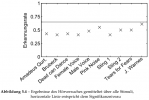As has been said, this topic has been discussed ad nauseam in all audio forums around the world.
Common sense and acceptance of physical realities provides already the answer, but it would be even better to have some kind of proof.
There is a German-language master's thesis on this subject that investigated the subjective perceptibility of sound differences with different types and materials of tweeters:
Perceptibility of tonal differences of tweeters with different principles of operation - "Wahrnehmbarkeit klanglicher Unterschiede von Hochtonlautsprechern unterschiedlicher Wirkprinzipien".
The following tweeters were tested together with identical woofer and a crossover frequency of 2kHz:
View attachment 262198
In order to exclude typical colorations of the sound due to room interaction as well as with the loudspeaker baffle, all drivers were tested in a quasi infinite baffle in a reflexion-free environment.
The on-axis frequency responses of the combinations of tweeter with woofer were phase (via FIR) and frequency response equalized (the results are not perfect but within +-1dB).
View attachment 262203
A dummy head was then used to create the HRTF via binaural impulse responses (
BIR) for all six speakers (six different tweeters, always the same woofer) and the speaker pairing with the largest difference in HRTF was selected for an ABX listening test (in simplified terms, the exact details are in the study).
The selected tweeter pairing consisted of a magnetostatic tweeter and a fabric ring radiator.
To allow a dynamic simulation of the loudspeaker pairs in a later comparison, the BIRs were recorded at a radius of typical head movements.
With the help of the binaural, dynamic simulations of the loudspeaker pairs, ten test persons were asked to find out, if there is still a difference between the tweeters, which can be determined by the subjective sound image - for this purpose, music and artificial signals were folded with the BIR.
All subjects stated that they had not found any auditory clue by which they could have identified one of the two tweeters. All hits were in the range of 50%, which suggests more or less arbitrary guessing by the subjects due to undetectable differences. The result of the evaluation of the hit rates over all test subjects is thus quasi confirmed.
View attachment 262264
Thus, when using tweeters with different design principles and diaphragm materials, no difference could be detected in stereo listening in the free field after phase and frequency response equalization.
So no one could distinguish the "super fast" membrane of the magnetostat tweeter from the fabric tweeter

No one was bothered by the different decay and distortion behavior of the tweeters - which highlights the low importance of these parameters (as long as there are no gross errors).
The chapter on the current state of research (which was 2010) summarizes interesting older work:
The last section also provides the explanation why many think they hear a difference with different tweeter membrane materials:
When using different materials, the radiation of the loudspeaker changes and this can lead to different auditory perceptions, but not the material itself, the same applies to the different operating principles for tweeters.
The deviations in radiation that can occur with completely identical tweeters with different diaphragm materials
were once shown here, for example.




